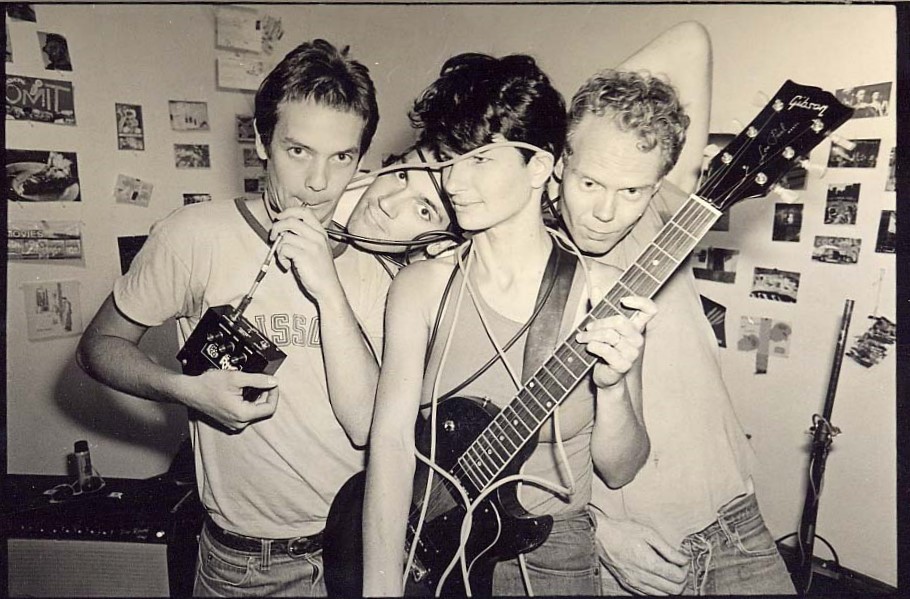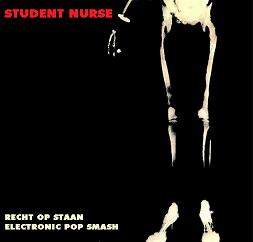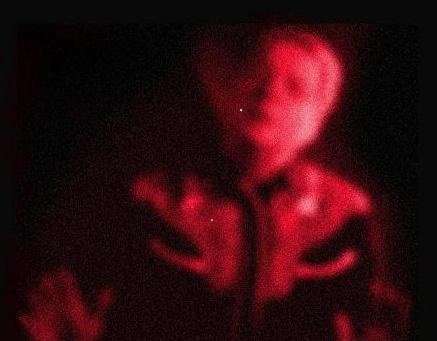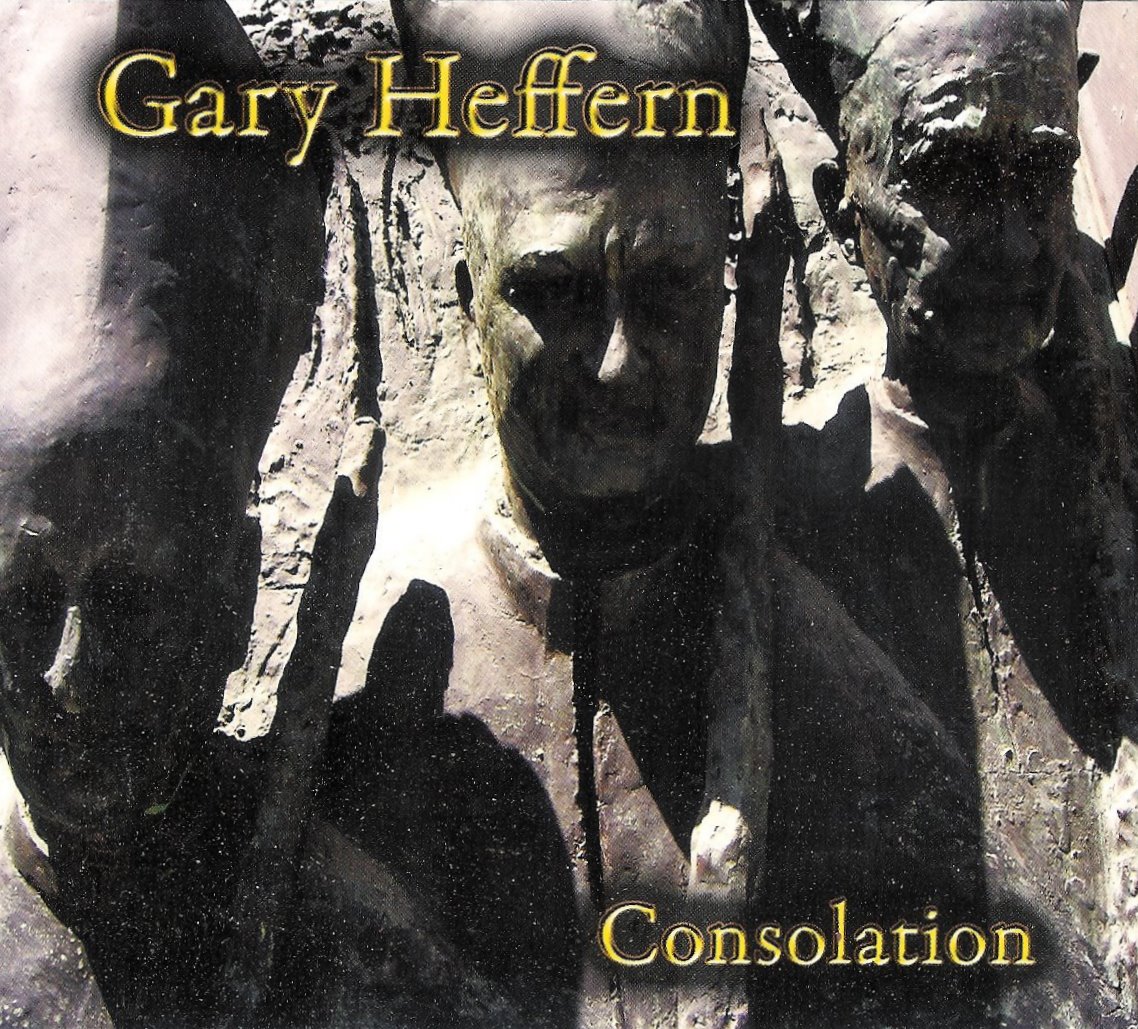Mark H. Smith-Guitar, Synthesizer, Vocals
MacKenzie Smith-Synthesizer, Vocals
Fred Chalenor-Bass
George Romansic-Drums
Colin McDonnell-Guitar, Synthesizer,
Taylor Little-Drums
Craig Florey-Saxophone
Jack Weaver-Trumpet
Jane Whistler- Background Vocals
The Macs
The Beakers
Curlew
Rally Go
American Technology, EP (Engram Records, 1982)
The Worker Works To Live, EP (Engram Records, 1982)
Bar 2000. Seattle Syndrome Volume 2 compilation (Engram Records, 1983)
Ron Petersen-Guitar
Joel Goodman-Drums
Chuck Schoning-Keyboards
Bob Hosko-Saxophone
Jim Manolides-Bass
Jon Keilehor-Drums
Jerry Miller-Guitar
Don Stevenson-Drums
Bob Mosely-Bass
And a cast of many more
The Complete Frantics on Dolton-The Frantics (Collector’s Choice Music, 2004)
Human Monkey b/w Someday- The Frantics , 7″ single (Action Records, 1966)
Moby Grape-Moby Grape (Columbia Records, 1967)
Moby Grape ’69-Moby Grape (Columbia Records, 1969)
More Oar: A Tribute to the Skip Spence Album-Compilation (Birdman Records 1999)
Moby Grape
The Four Frantics
Nancy Claire
Luminous Marsh Gas
The Daily Flash
Paleface
Jr. Cadillac
The Ventures
The Wailers
The Hi-Fi’s
The Fleetwoods
The Ventures
Ned Miller
Paul Tatmarc
Dolton Records
Jerden Records
Dot Records
Columbia Records
Jim Coile-Saxophone, Flute, Clarinet
Ronnie Hammon-Drums
Tim McFarland-Trombone, Piano
Billy McPherson-Saxophone
Luther Rabb-Bass
Glenn Thomas-Guitar
Jim Walters-Trumpet, Vocals
Santana
War
Luther Rabb
Lola Falana
Jimi Hendrix
Ballin’Jack-Columbia (1970)
Buzzard Luck-Columbia (1972)
Special Pride-Mercury (1973)
Live And In Color-Mercury (1974)
I hope that she won’t fail because I feel so good, I feel so good.
You know I feel so good, feel like balling the jack
As Bessie Smith sang in “Baby Doll” in 1926,
He can be ugly, he can be black
So long as he can eagle rock and ball the jack
There’s several ways to interpret the term, but “ballin the jack” was an expression often used in jazz and blues circles to mean deep, full and fast sex. It may be this veiled, slang reference is the meaning the band intended their name to represent.
Ballin’ Jack found themselves moving to Los Angeles, living in a large house cum-home studio near the Sunset Strip. Although all of the members had put plenty of time paying dues, their signing to Columbia Records and tour success came almost immediately, partly due to the encouragement of their old friend Jimi Hendrix. … Read more›
Gary Minkler-Vocals
Bill Bagley- Bass, Keyboards, Guitar
Jerry Anderson- Bass
Walt Singleman-Bass
Gregg Keplinger-Drums
Bill Shaw- Drums, Vocals
Don Kamerer-Drums
John Olufs- Guitar, Vocals
Pete Pendras- Guitar, Vocals
Emily Bishton- Vocals
Rudy Harper-Trumpet
Don Kellman- Tenor Sax
Dave Conant-Guitar, RIP
Little Ship-Popllama (1985)
Bob Was A Robot b/w Pteradactyl Teenagers (7″single) Glassmouth Records (1980)
Money Dream b/w I Like To Eat My Mousies Raw (7″single) PopLLama (1984)
The Collection (Compilation) PopLLama (1994)
Little Trailer Ruby-Gary Minkler PopLLama (2013)
Byron Duff-Guitar, vocals
Stanford Filarca-Bass, vocals
Jeff Farrand- Drums
“Idiot Culture” & “Call It Chaos” Pravda Volume One, compilation, cassette only, Pravda Records (1982)
“Call It Chaos” That’s Dadastic compilation, Dadastic Sounds (2011)
Dive
Moth
Idiot Culture
Beat Pagodas
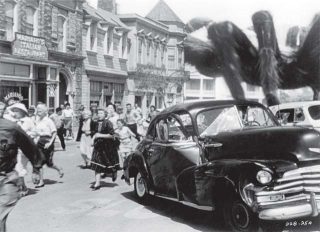 The Spectators played fewer than 20 gigs. They performed only 15 songs live. But their reputation as one of the most original and accomplished bands of the early Seattle alternative scene continues to grow into the 21st century. Their first gig was December 8th 1980, the same day John Lennon was gunned down in New York City. It was just like most other nights at Seattle’s legendary Gorilla Room on Second Avenue; a handful of people showed up, and more free beer was drunk up by the bar staff and their under-aged buddies than was ever sold. But that night one of the finest Seattle bands of the era played to the nearly empty club. Over the next few months the band would be regulars at the Gorilla Room and WREX and end up on the stage of Seattle’s Showbox Theater at least twice, as co-headliners, and as openers for The Stranglers. Later, Bob Mould, having played three dates with The Spectators while on the first national tour by Hüsker Dü , called them “the greatest unsigned band in America“. Less than a yearlater The Spectators were gone.
The Spectators combination of surf, metal, jazz and punk predates most alt bands with similar influences by a full decade. They were a power-trio, but one that dealt their deadly blows with intricate and subtle precision rather than blind swings. This was a band that had brains as well as brawn. By using a limited amount ofeffects, guitarist Byron Duff and bass player Stanford “Stan” Filarca created a sound so tightly woven that it was hard totell who was playing lead, where the rhythm was coming from and how they could possibly sound so big and layered at the same time. Add to the mix the powerful, inventive and perfect tempo of drummer Jeff Farrand and it’s hard to think of any finer trio in rock, signed or unsigned, even today.
During their short life The Spectators recorded very little of their output in the studio-about six studio tracks still exist. Unfortunately most of it has been lost or the tapes have degraded so badly they’re practically unlistenable. Fortunately there still are some fairly high quality mono recording caught on a cassette player using a condenser mike! Some of these cassettes and board mixes have been discovered, including this recording of Call It Chaos. One-time Seattle promoter and indie label owner Maire Masco found an almost-perfect copy of the song (and four others) hidden away in an attic.… Read more›
The Spectators played fewer than 20 gigs. They performed only 15 songs live. But their reputation as one of the most original and accomplished bands of the early Seattle alternative scene continues to grow into the 21st century. Their first gig was December 8th 1980, the same day John Lennon was gunned down in New York City. It was just like most other nights at Seattle’s legendary Gorilla Room on Second Avenue; a handful of people showed up, and more free beer was drunk up by the bar staff and their under-aged buddies than was ever sold. But that night one of the finest Seattle bands of the era played to the nearly empty club. Over the next few months the band would be regulars at the Gorilla Room and WREX and end up on the stage of Seattle’s Showbox Theater at least twice, as co-headliners, and as openers for The Stranglers. Later, Bob Mould, having played three dates with The Spectators while on the first national tour by Hüsker Dü , called them “the greatest unsigned band in America“. Less than a yearlater The Spectators were gone.
The Spectators combination of surf, metal, jazz and punk predates most alt bands with similar influences by a full decade. They were a power-trio, but one that dealt their deadly blows with intricate and subtle precision rather than blind swings. This was a band that had brains as well as brawn. By using a limited amount ofeffects, guitarist Byron Duff and bass player Stanford “Stan” Filarca created a sound so tightly woven that it was hard totell who was playing lead, where the rhythm was coming from and how they could possibly sound so big and layered at the same time. Add to the mix the powerful, inventive and perfect tempo of drummer Jeff Farrand and it’s hard to think of any finer trio in rock, signed or unsigned, even today.
During their short life The Spectators recorded very little of their output in the studio-about six studio tracks still exist. Unfortunately most of it has been lost or the tapes have degraded so badly they’re practically unlistenable. Fortunately there still are some fairly high quality mono recording caught on a cassette player using a condenser mike! Some of these cassettes and board mixes have been discovered, including this recording of Call It Chaos. One-time Seattle promoter and indie label owner Maire Masco found an almost-perfect copy of the song (and four others) hidden away in an attic.… Read more›
Mike Refuzor-Vocals, Bass, Guitar (1978-1989)
Roach Refuzor-Drums (1978-1989
Danny Refuzor-Guitar (1978-1989
Ward Refuzor-Guitar
Al Dams-Guitar
Mike Purdon-Bass
Renee Refuzor-Vocals
Tom Hansen-Guitar
Mike Refuzor-Guitar, Vocals (1993)
John Carey-Bass (1993)
Dan Bradshaw-Guitar (1993)
Al Cannibal-Guitar (1993
Alex Maggot Brains-Bass (1993
Aldo Dams-Drums (1993)
White Power-Seattle Syndrome Compilation Engram Records (1981)
Q.Why Do It, You’ll Never Get Rich A.Cuz I’m A Refuser-Cassette Only- Rizz Records (1987)
Think I Lost My Faith b/w Jim Jones 7″-Bag of Hammers Records (1993)
Flashback-Idol Records (1997)
The fact is the song’s lyrics make clear that they did NOT support white supremacy. The lyrics start:
People may say things about me.
Some of them things are true, some are lies
With the power of the press you labeled me a Nazi
I bet you can’t even look me in the eyes
Later in the chorus Mike sings;
I never said White Power
I never said White Power to you
White Power
I’m sayin’ it now
You put those words in my mouth…
A studio version of the song was included on the near-legendary “Seattle Syndrome” compilation, but it seems as of this writing there are only very poorly recorded live versions of the song available on the internet. Aside from the inclusion on The Seattle Syndrome The Refuzors released a cassette-only project in 1987 titled “Q.… Read more›
Pamela Golden-Guitar
Rebecca Hamilton-Bass
Laura Keane-Vocals & Percussion
Ron Simmons-Drums
The Visible Targets-Park Avenue Records (1982)
Autistic Savant-Park Avenue Records (1983)
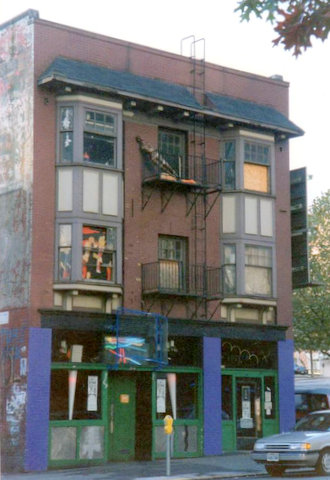 WREX was established in Belltown, Seattle by Michael Clay, Wes Bradley, and Aaron McKiernan in the early Fall of 1979. The venue, at 2018 First Avenue, was formerly a leather gay bar called Johnny’s Handlebar, located on the ground floor of a former brothel. Johnny’s Handlebar, at the time it closed was said to be the oldest, continuously open gay bar on the West Coast. For the first few months of it’s life WREX remained a typical 70s/80s gay bar, catering to local gay men. The unique décor inside WREX included old car seats in the back, old airplane seats in the side area, and Seattle’s first music video system curated by Ted Ladd. A DJ spun the popular music found in thousands of gay discos around the nation (and in Seattle) which also included a handful of the poppier “new wave” hits that most gay bars also included among their playlists. As the novelty of the new gay bar wore off the gay clientele retreated to many of their previous haunts around town. The Brass Door, Neighbors, The Park Avenue, and a plethora of other LGBT venues that were popping up with regularity. WREX was still viable as a business, but they needed something more to bring in customers. One of the targets WREX had not yet tapped into was the growing popularity of punk in the LGBT community Many who came of age during the punk era rejected the “clone” culture that pervaded the gay scene at the time. Not only that, alot of younger straight adults interested in punk barely regarded a difference between themselves and their queer friends. They all gravitated toward punk as an alternative, so they were all one tribe. It’s not surprising that gays bars were regularly part of the punk scene of the late 70’s and early 80’s. They were always ready to allow punk rock in their midst because it represented the same kind of outsidership, and it’s no wonder so many gay youth were willing to embrace more outré artists that had emerged from gay disco-artists like Sylvester and the iconic Grace Jones.
Seattle’s punk and gay communities have often mingled together, and the subcultural mise-en-scène at WREX was no exception to that general rule. Occasionally, former Johnny’s Handlebar clientele would drop in after WREX’s opening, not yet knowing about the change in management and regular crowd. Since both gays and punks were then equally shunned by mainstream Seattleites, there was no true clash between the two subcultures.… Read more›
WREX was established in Belltown, Seattle by Michael Clay, Wes Bradley, and Aaron McKiernan in the early Fall of 1979. The venue, at 2018 First Avenue, was formerly a leather gay bar called Johnny’s Handlebar, located on the ground floor of a former brothel. Johnny’s Handlebar, at the time it closed was said to be the oldest, continuously open gay bar on the West Coast. For the first few months of it’s life WREX remained a typical 70s/80s gay bar, catering to local gay men. The unique décor inside WREX included old car seats in the back, old airplane seats in the side area, and Seattle’s first music video system curated by Ted Ladd. A DJ spun the popular music found in thousands of gay discos around the nation (and in Seattle) which also included a handful of the poppier “new wave” hits that most gay bars also included among their playlists. As the novelty of the new gay bar wore off the gay clientele retreated to many of their previous haunts around town. The Brass Door, Neighbors, The Park Avenue, and a plethora of other LGBT venues that were popping up with regularity. WREX was still viable as a business, but they needed something more to bring in customers. One of the targets WREX had not yet tapped into was the growing popularity of punk in the LGBT community Many who came of age during the punk era rejected the “clone” culture that pervaded the gay scene at the time. Not only that, alot of younger straight adults interested in punk barely regarded a difference between themselves and their queer friends. They all gravitated toward punk as an alternative, so they were all one tribe. It’s not surprising that gays bars were regularly part of the punk scene of the late 70’s and early 80’s. They were always ready to allow punk rock in their midst because it represented the same kind of outsidership, and it’s no wonder so many gay youth were willing to embrace more outré artists that had emerged from gay disco-artists like Sylvester and the iconic Grace Jones.
Seattle’s punk and gay communities have often mingled together, and the subcultural mise-en-scène at WREX was no exception to that general rule. Occasionally, former Johnny’s Handlebar clientele would drop in after WREX’s opening, not yet knowing about the change in management and regular crowd. Since both gays and punks were then equally shunned by mainstream Seattleites, there was no true clash between the two subcultures.… Read more›
John Rogers-Drums
Helena Rogers-Lead Guitar, Vocals
Allen Evans-Rhythm Guitar (1979-1980)
William Adams-Bass, Synth (1979-1980)
Eric Muhs-Bass (1980-1984)
Tom Boetcher-Guitar (1981-1984)
Disco Dog b/w Lies/Snow (7″)-Spunkrock Records (1979)
As Seen On TV (EP)-Rug Records (1980)
Discover Your Feet-Seattle Syndrome Volume One- Engram Records (1981)
Recht Op Staan b/w Electronic Pop Smash (7″)-Pravda Records (1982)
Bald Tires In The Rain – Nocturnal Records (1990)
Painful Days – Glitterhouse Records (1995)
Askew – Belltown Records (1997)
Consolation – fin-rosa (2008)
The Penetrators
The Center For Disease Control Boys
Gary Heffern & The Beautiful People
Seattle rock critic and well-known author Charles R. Cross writes:”In Heffern’s own songs there is a constant struggle between darkness and light, between failed dreams and reckless prayer, between a world where all hope is lost and one where a consoling friend offers a sliver of deliverance. Even on a song as haunting as “(I Am Your) Destroyer” from the album “Consulation” sounds like Iggy Pop could have written it. There is still a core of sweetness among the ruins. “That’s the Beauty (Of the Little Things in Life)” truly rings with a ghost: It was written in Seattle’s Comet Tavern on the very night that Gits’ singer Mia Zapata went missing (and later turned up murdered). Not only a remarkable timepiece, “That’s the Beauty” demonstrates Heffern’s skill at creating a story arc that celebrates the fragility of life at the same time it bemoans it. It’s the kind of re-framing that is uniquely Gary Heffern”.
Aside from his songwriting, albums. online music and live performances, Gary has also been the subject of Finnish filmmaker Erkki Määttänen’s “Sweet Kisses From Mommy” It recounts Gary’s birth in Finland as Veli-Matti Tervaneimi through his adoption, childhood and renaming and growing up in 1950s and 60s San Diego.… Read more›
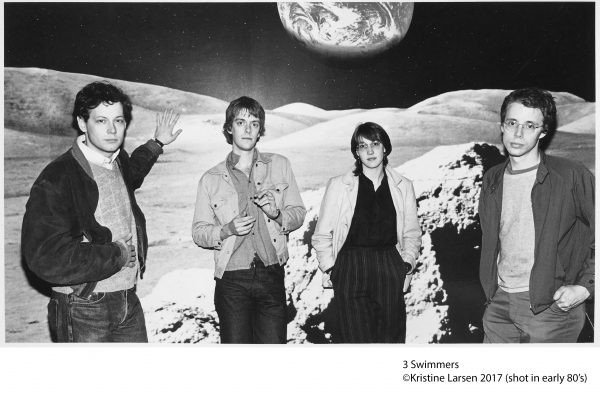
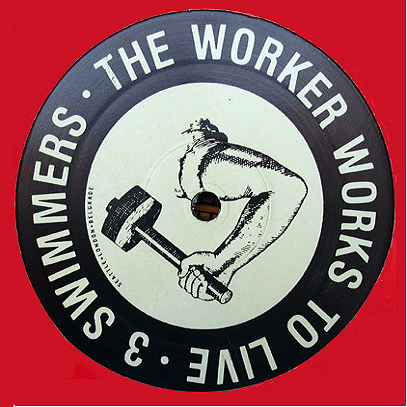



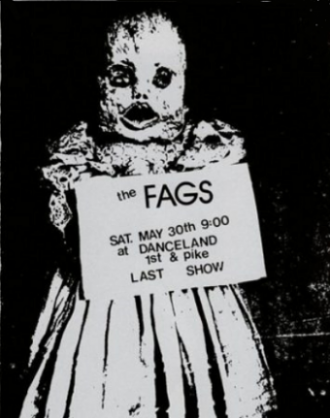
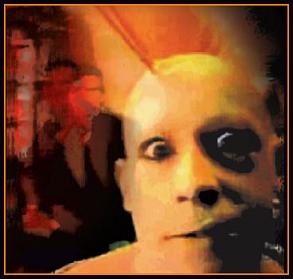
 The Fags might be the most fun Seattle bands to play ‘six degrees of separation’ with…except you’d only have to play with one or two degrees. Direct ties lead everywhere from 70’s Omni-sexual performers Ze Whiz Kidz, to neo-hippies Sky Cries Mary; from The Lewd to showgirl Julie Miller and The Casino de Monte Carlo and from John Holbrook, Bearsville engineer/designer and the man who mastered classic albums like ‘Tommy’ and Hendrix’s ‘Axis: Bold as Love, to Gordon Raphael-producer of The Strokes and Regina Spektor among others. From the skillfully written and recorded duo Such to the grimy recording of ‘Raping Dead Nuns by the band Solger, Seattle’s first hard-core band…and those connections barely scratch the surface.
The band rose out of a loose-knit community of musician-friends and punks that came and left Seattle’s infamous Fag House during the 1980’s. Before that many had been friends living off a sugar-daddy Charles Upchuck Gerra while he performed in his first band, Clone. In 1980 former drummer for the glamorous Julie Miller wunderkid drummer Ben Ireland, his filmmaking, multi-talented sister, Barbara Ireland. legendary guitarist Paul Solger (taking the name of his band) joined with poet/painter Dahny Reed to work as a unit. The band would be dubbed “The Fags” by local promoter Steve Pritchard when the band went onstatge one night at the Lincoln Arts Center. Pritchard did not know the name the band had planned to perform under that night-and neither did the band, apparently. So in announcing them Pritchard simply walked onstage and yelled out “Ladies and Gentlemen-The FAGS! The name stuck and together they created some of the most outrageous stage performances ever seen in Seattle….and later in downtown New York where the band re-located in the mid 1980’s. During the time that Barb Ireland spent at NYU’s film school the band’s bass was held on by Jane Playtex-then the wife of Steve Hoffman of one of the most hardcore bands of the day, The Fartz.
Studio recordings of the band are rare, but The Fags were good at getting friends to catch video and audio of many of their performances. Most were done on the fly and not up to the standard we are used to in the digital age…but they are certainly well-loved documents made by devoted fans and co-conspirators. Of their recorded output the song Lock You Up (recorded in NYC) might be the most accurate summation of the band’s approach. …
The Fags might be the most fun Seattle bands to play ‘six degrees of separation’ with…except you’d only have to play with one or two degrees. Direct ties lead everywhere from 70’s Omni-sexual performers Ze Whiz Kidz, to neo-hippies Sky Cries Mary; from The Lewd to showgirl Julie Miller and The Casino de Monte Carlo and from John Holbrook, Bearsville engineer/designer and the man who mastered classic albums like ‘Tommy’ and Hendrix’s ‘Axis: Bold as Love, to Gordon Raphael-producer of The Strokes and Regina Spektor among others. From the skillfully written and recorded duo Such to the grimy recording of ‘Raping Dead Nuns by the band Solger, Seattle’s first hard-core band…and those connections barely scratch the surface.
The band rose out of a loose-knit community of musician-friends and punks that came and left Seattle’s infamous Fag House during the 1980’s. Before that many had been friends living off a sugar-daddy Charles Upchuck Gerra while he performed in his first band, Clone. In 1980 former drummer for the glamorous Julie Miller wunderkid drummer Ben Ireland, his filmmaking, multi-talented sister, Barbara Ireland. legendary guitarist Paul Solger (taking the name of his band) joined with poet/painter Dahny Reed to work as a unit. The band would be dubbed “The Fags” by local promoter Steve Pritchard when the band went onstatge one night at the Lincoln Arts Center. Pritchard did not know the name the band had planned to perform under that night-and neither did the band, apparently. So in announcing them Pritchard simply walked onstage and yelled out “Ladies and Gentlemen-The FAGS! The name stuck and together they created some of the most outrageous stage performances ever seen in Seattle….and later in downtown New York where the band re-located in the mid 1980’s. During the time that Barb Ireland spent at NYU’s film school the band’s bass was held on by Jane Playtex-then the wife of Steve Hoffman of one of the most hardcore bands of the day, The Fartz.
Studio recordings of the band are rare, but The Fags were good at getting friends to catch video and audio of many of their performances. Most were done on the fly and not up to the standard we are used to in the digital age…but they are certainly well-loved documents made by devoted fans and co-conspirators. Of their recorded output the song Lock You Up (recorded in NYC) might be the most accurate summation of the band’s approach. … 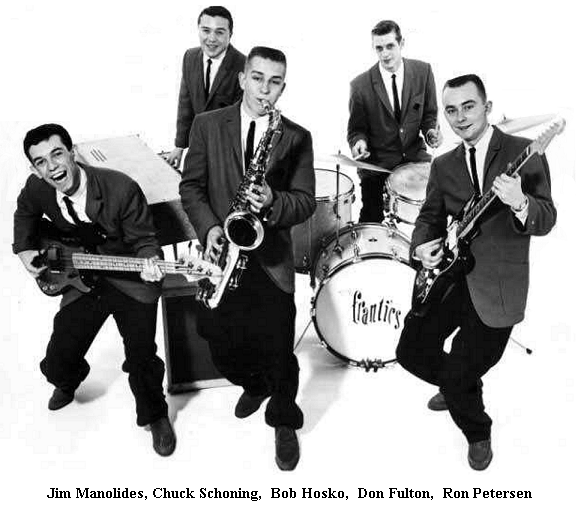
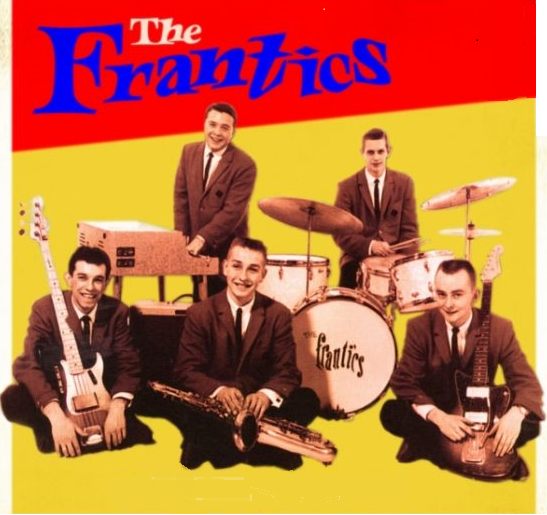
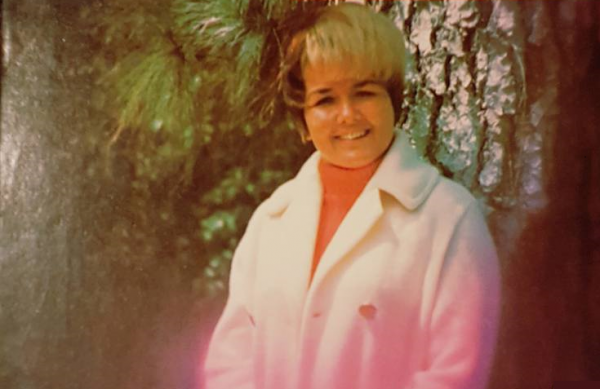
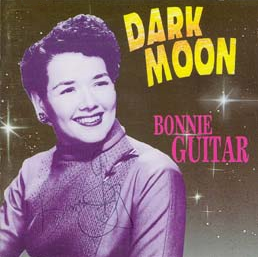
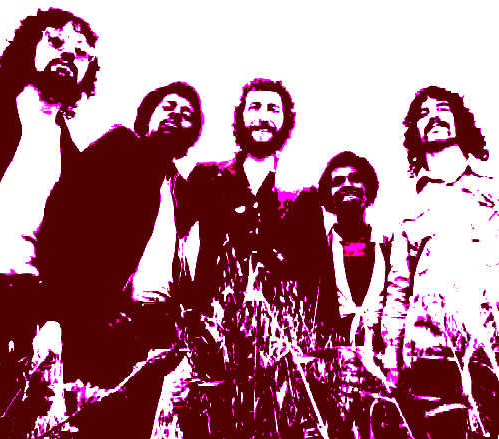
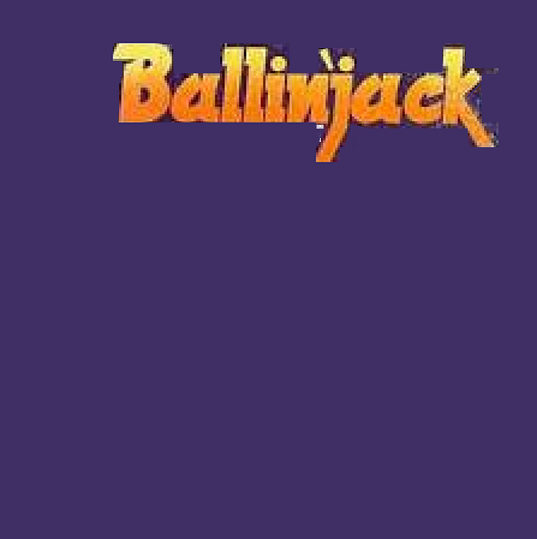
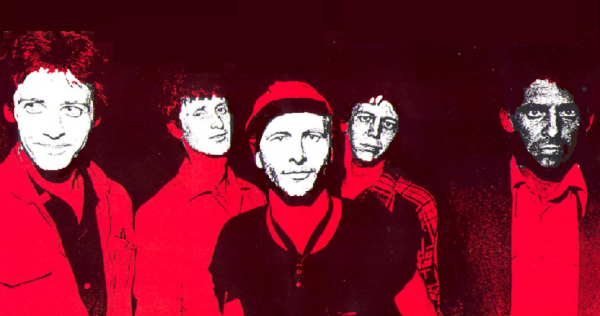
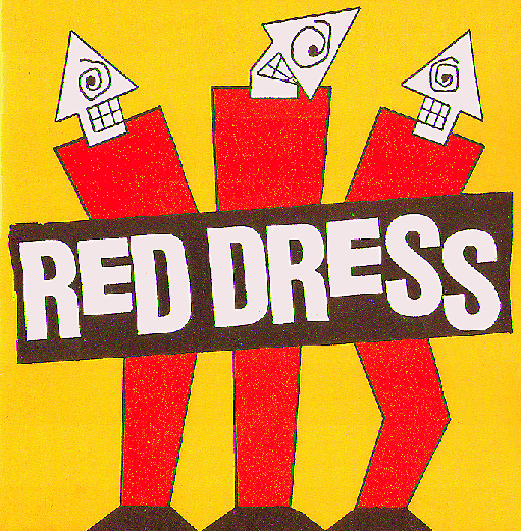
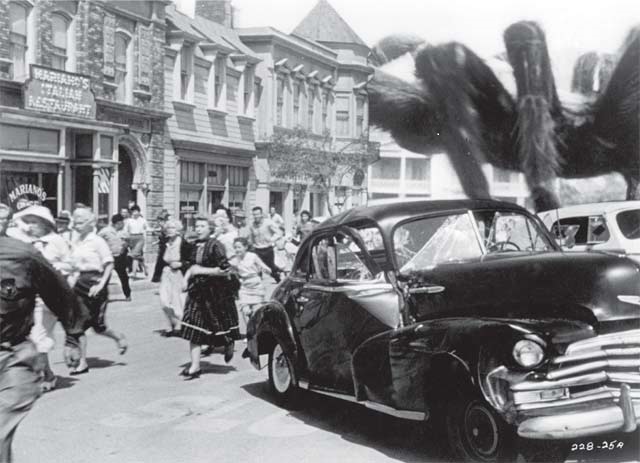
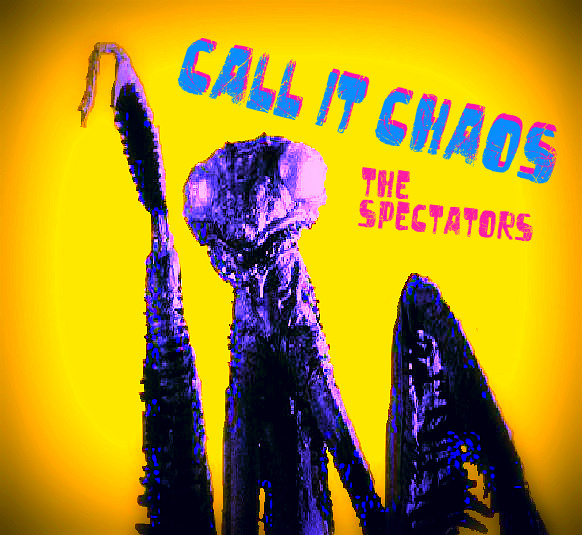
 The Spectators played fewer than 20 gigs. They performed only 15 songs live. But their reputation as one of the most original and accomplished bands of the early Seattle alternative scene continues to grow into the 21st century. Their first gig was December 8th 1980, the same day John Lennon was gunned down in New York City. It was just like most other nights at Seattle’s legendary Gorilla Room on Second Avenue; a handful of people showed up, and more free beer was drunk up by the bar staff and their under-aged buddies than was ever sold. But that night one of the finest Seattle bands of the era played to the nearly empty club. Over the next few months the band would be regulars at the Gorilla Room and WREX and end up on the stage of Seattle’s Showbox Theater at least twice, as co-headliners, and as openers for The Stranglers. Later, Bob Mould, having played three dates with The Spectators while on the first national tour by
The Spectators played fewer than 20 gigs. They performed only 15 songs live. But their reputation as one of the most original and accomplished bands of the early Seattle alternative scene continues to grow into the 21st century. Their first gig was December 8th 1980, the same day John Lennon was gunned down in New York City. It was just like most other nights at Seattle’s legendary Gorilla Room on Second Avenue; a handful of people showed up, and more free beer was drunk up by the bar staff and their under-aged buddies than was ever sold. But that night one of the finest Seattle bands of the era played to the nearly empty club. Over the next few months the band would be regulars at the Gorilla Room and WREX and end up on the stage of Seattle’s Showbox Theater at least twice, as co-headliners, and as openers for The Stranglers. Later, Bob Mould, having played three dates with The Spectators while on the first national tour by 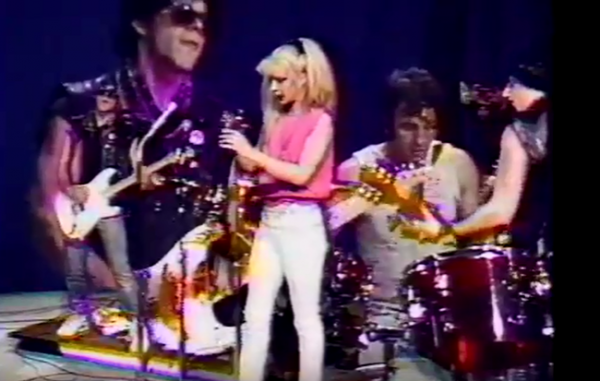
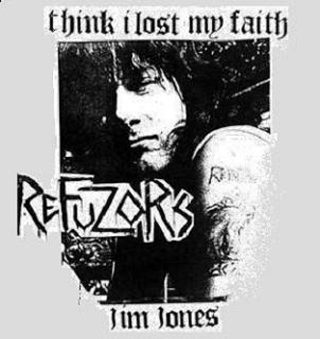
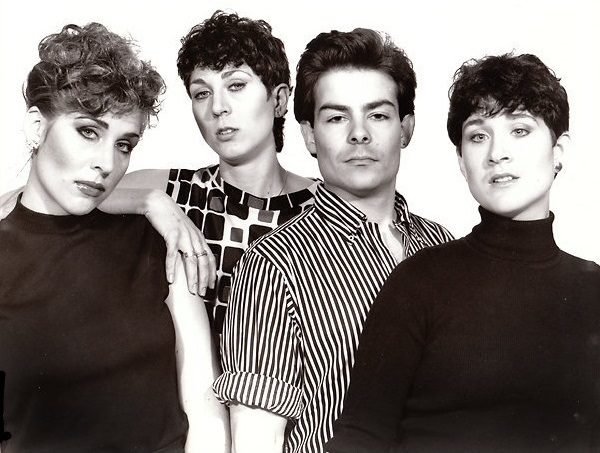
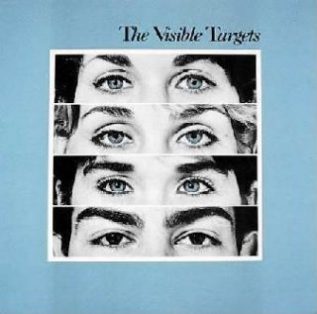

 WREX was established in Belltown, Seattle by Michael Clay, Wes Bradley, and Aaron McKiernan in the early Fall of 1979. The venue, at 2018 First Avenue, was formerly a leather gay bar called Johnny’s Handlebar, located on the ground floor of a former brothel. Johnny’s Handlebar, at the time it closed was said to be the oldest, continuously open gay bar on the West Coast. For the first few months of it’s life WREX remained a typical 70s/80s gay bar, catering to local gay men. The unique décor inside WREX included old car seats in the back, old airplane seats in the side area, and Seattle’s first music video system curated by Ted Ladd. A DJ spun the popular music found in thousands of gay discos around the nation (and in Seattle) which also included a handful of the poppier “new wave” hits that most gay bars also included among their playlists. As the novelty of the new gay bar wore off the gay clientele retreated to many of their previous haunts around town. The Brass Door, Neighbors, The Park Avenue, and a plethora of other LGBT venues that were popping up with regularity. WREX was still viable as a business, but they needed something more to bring in customers. One of the targets WREX had not yet tapped into was the growing popularity of punk in the LGBT community Many who came of age during the punk era rejected the “clone” culture that pervaded the gay scene at the time. Not only that, alot of younger straight adults interested in punk barely regarded a difference between themselves and their queer friends. They all gravitated toward punk as an alternative, so they were all one tribe. It’s not surprising that gays bars were regularly part of the punk scene of the late 70’s and early 80’s. They were always ready to allow punk rock in their midst because it represented the same kind of outsidership, and it’s no wonder so many gay youth were willing to embrace more
WREX was established in Belltown, Seattle by Michael Clay, Wes Bradley, and Aaron McKiernan in the early Fall of 1979. The venue, at 2018 First Avenue, was formerly a leather gay bar called Johnny’s Handlebar, located on the ground floor of a former brothel. Johnny’s Handlebar, at the time it closed was said to be the oldest, continuously open gay bar on the West Coast. For the first few months of it’s life WREX remained a typical 70s/80s gay bar, catering to local gay men. The unique décor inside WREX included old car seats in the back, old airplane seats in the side area, and Seattle’s first music video system curated by Ted Ladd. A DJ spun the popular music found in thousands of gay discos around the nation (and in Seattle) which also included a handful of the poppier “new wave” hits that most gay bars also included among their playlists. As the novelty of the new gay bar wore off the gay clientele retreated to many of their previous haunts around town. The Brass Door, Neighbors, The Park Avenue, and a plethora of other LGBT venues that were popping up with regularity. WREX was still viable as a business, but they needed something more to bring in customers. One of the targets WREX had not yet tapped into was the growing popularity of punk in the LGBT community Many who came of age during the punk era rejected the “clone” culture that pervaded the gay scene at the time. Not only that, alot of younger straight adults interested in punk barely regarded a difference between themselves and their queer friends. They all gravitated toward punk as an alternative, so they were all one tribe. It’s not surprising that gays bars were regularly part of the punk scene of the late 70’s and early 80’s. They were always ready to allow punk rock in their midst because it represented the same kind of outsidership, and it’s no wonder so many gay youth were willing to embrace more 